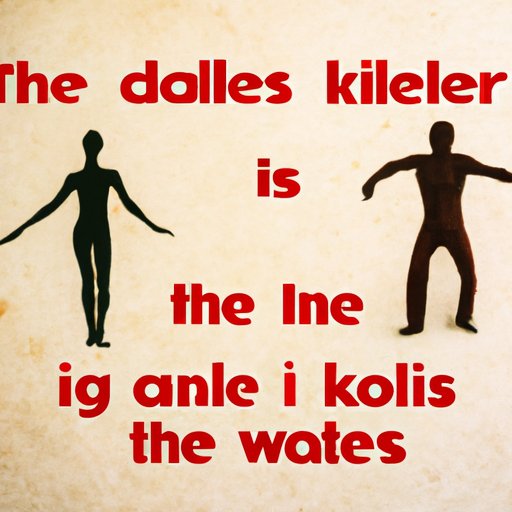In the realm of modern music, a myriad of lyrics beckons exploration beneath the surface layers of melody and rhythm. Among these, The Killers’ enigmatic song “Are We Human or Are We Dancer?” transcends simple auditory pleasure, challenging listeners to engage with profound existential questions. The phrase itself serves as an intriguing metaphor encapsulating the perennial human dilemma of identity and purpose. Through a lens of cultural relativism, we can dissect the layers of meaning inherent in the song’s lyrics, drawing connections to broader sociocultural themes that resonate across different contexts.
The opening inquiry—“Are we human or are we dancer?”—invokes a duality that juxtaposes the corporeal existence of humanity against the abstract notion of dance. Here, “human” symbolizes the multifaceted nature of human experience, encompassing cognition, emotion, and the complexities of social interactions. Conversely, “dancer” evokes an ephemeral quality, suggesting a life characterized by performance, aesthetic expression, and a searching for meaning through movement. This duality urges listeners to contemplate whether existence is grounded in the intrinsic attributes of being human or if it demands a performance that meets societal expectations.
From a cultural relativism perspective, the interpretation of this duality can vary significantly across different societies. In cultures where collectivism prevails, the idea of being a “dancer” may reflect an emphasis on conformity and the necessity of adhering to communal norms. In such contexts, individuals might feel compelled to navigate existence as performers, showcasing their values and beliefs in a way that aligns with cultural expectations. The pressure to conform can diminish the essence of individuality, which invites a poignant consideration of autonomy versus communal identity.
On the contrary, in more individualistic societies, the metaphor of the “dancer” may allude to the celebration of personal freedom and creativity. In these contexts, to dance signifies the pursuit of one’s passions and desires—an embodiment of self-expression and authenticity. The tension between being human and being a dancer becomes a reflection of a culture that values personal authority and subjective experience over collective agreement. This dichotomy raises questions about how cultural orientations shape our understanding of self and community.
Moreover, the song’s lyrics highlight a broader existential crisis that resonates throughout various cultural narratives. The concept of existentialism posits that individuals must forge their own meaning within an indifferent universe. Herein lies a poignant observation: the struggle for identity is not merely a personal endeavor but a social phenomenon deeply influenced by cultural frameworks. The inquiry posed in the song encapsulates this crisis, wherein identity formation oscillates between innate human qualities and externally imposed roles.
Intriguingly, the use of the word “dancer” can also be interpreted in light of historical and cultural contexts. Dance has served as a vital expression of culture across civilizations, often entwined with ritual, myth, and communal storytelling. To be a dancer can signify embracing one’s cultural heritage and participating in a larger narrative that transcends individual experience. In this sense, the lyric resonates as an invitation to reflect on the ways cultural constructs shape our understanding of existence.
As the song progresses, the repetition of the central question amplifies its urgency and complexity. This reiteration not only reinforces the thematic dichotomy but also serves as a commentary on the human condition itself. The cyclical nature of questioning mirrors the continuous search for meaning inherent in the human experience. Within this construct, the act of questioning can be seen as a cultural artifact—a behavior stemming from a collective urge to navigate the perplexities of life and existence.
Cultural relativism also invites a critique of sociopolitical structures that influence our understanding of what it means to be human or a dancer. The implications of power dynamics play a significant role in shaping identity. For example, marginalized groups may find themselves caught in a struggle between asserting their humanity against the societal roles imposed upon them as dancers in a pre-defined narrative. This aspect of the song resonates with contemporary discourses on identity politics, offering a lens through which we can examine the manifestations of power, agency, and resistance across diverse cultures.
Furthermore, the song’s appeal lies in its ability to prompt introspection and discourse on the foundational questions of existence. It questions the social constructs that dictate how we perform our identities and the extent to which we allow external factors to shape our perceptions of self. Within this reflective practice, listeners are encouraged to examine their own lives, urging a deeper understanding of the dichotomies that govern their experiences. Are we passive participants in the grand performance of life, or do we actively engage in crafting our narratives?
In conclusion, “Are We Human or Are We Dancer?” serves as more than just a lyrical inquiry; it functions as a cultural touchstone prompting dialogue about the interplay between identity, culture, and existence. Viewed through the lens of cultural relativism, the song illuminates the complexities of human experience and the myriad ways in which culture shapes our perceptions of self and community. Ultimately, The Killers’ incisive lyrics remind us that the questions of identity and purpose are not bound to singular definitions; rather, they are deeply contextual, fluid, and reflective of the intricate tapestry of human relationships and experiences.
